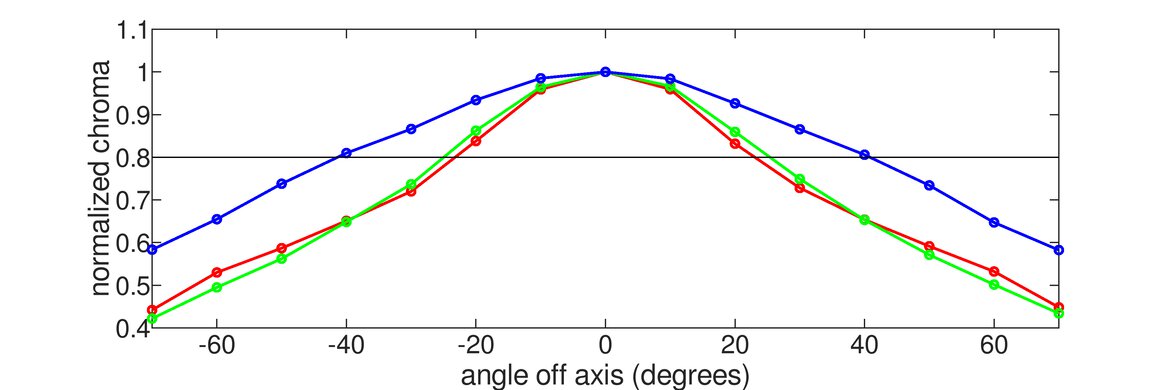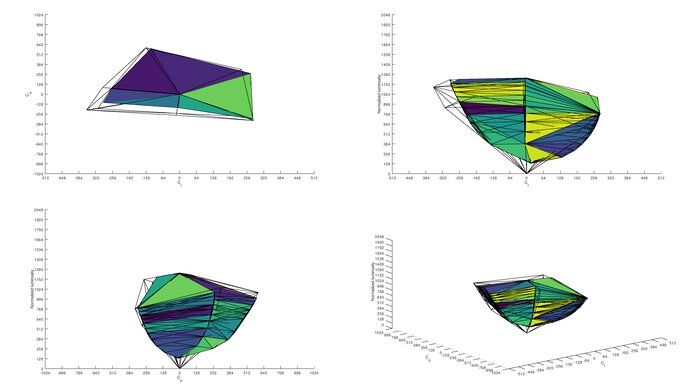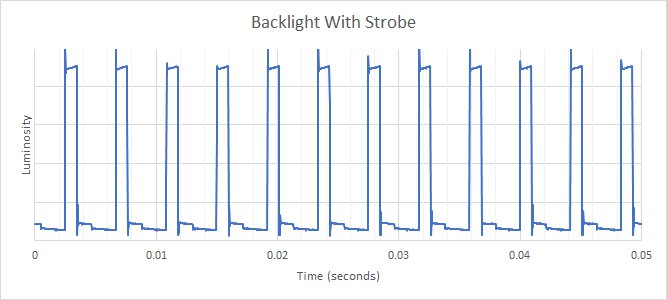The HP OMEN 27c is a 1440p gaming monitor part of HP's OMEN lineup. It's the first in the lineup to have a VA panel and a 240Hz refresh rate, as their models in the past with that high refresh rate had TN panels. The VA panel is supposed to deliver better dark room picture quality as it has a good native contrast ratio. However, its local dimming feature that automatically turns on in HDR performs terribly and causes blooming. In addition to the fast refresh rate, it has native FreeSync variable refresh rate (VRR) support with G-SYNC compatibility to reduce screen tearing. It has low input lag for a responsive gaming experience, and although it has a quick overall response time, there's black smearing with dark objects. Unfortunately, it's not ideal for office work because it has narrow viewing angles, and its stand offers limited ergonomic adjustments. Also, while the 1000R curved screen is good if you're sitting directly in front of it, it's not ideal for co-op gaming.

We buy and test more than 30 monitors each year, with units that we buy completely on our own, without any cherry-picked units or samples. We put a lot into each unbiased, straight-to-the-point review, and there's a whole process from purchasing to publishing, involving multiple teams and people. We do more than just use the monitor for a week; we use specialized and custom tools to measure various aspects with objective data-based results. We also consider multiple factors before making any recommendations, including the monitor's cost, its performance against the competition, and whether or not it's easy to find.
Our Verdict
The HP OMEN 27c is good for mixed usage. It's designed for gaming and offers great performance as it has a fast 240Hz refresh rate. It also has VRR support, a quick response time, and low input lag for a responsive gaming experience. Sadly, it's not the best for HDR gaming because its local dimming feature is terrible and causes blooming around bright objects. It's decent for office use and good for content creators because of its 1440p resolution and 27 inch screen, but it has narrow viewing angles, and the ergonomics are disappointing.
- 1440p resolution with good text clarity and sharp images.
- Good reflection handling.
- Fast 240Hz refresh rate and VRR support.
- Limited ergonomics.
- Black smearing with dark objects.
- Terrible local dimming feature in HDR.
The HP OMEN 27c is decent for office use. It has a large screen with a high 1440p resolution, making it easier to open windows side-by-side, and the text clarity is good. However, it has disappointing ergonomics as you can't swivel the stand, and the narrow viewing angles make it less-than-ideal for sharing your screen with others. Also, while it has good reflection handling and decent peak brightness, it doesn't perform well in really bright rooms.
- 1440p resolution with good text clarity and sharp images.
- Good reflection handling.
- Low input lag.
- Narrow viewing angles.
- Limited ergonomics.
- Not bright enough to fight intense glare.
The HP OMEN 27c is great for gaming. It has a high 240Hz refresh rate with FreeSync VRR support and G-SYNC compatibility to deliver a nearly tear-free gaming experience. It also has low input lag and a quick response time, but you'll notice black smearing with some fast-moving objects. It's a good choice for dark room gaming because it has a good native contrast ratio, but the black uniformity is disappointing. Sadly, it's bad for co-op gaming because of its narrow viewing angles and limited ergonomics.
- Low input lag.
- Fast 240Hz refresh rate and VRR support.
- Quick response time in most transitions.
- Good native contrast ratio in SDR.
- Black smearing with dark objects.
- Disappointing black uniformity.
The HP OMEN 27c is good for watching multimedia content. The 27 inch screen is big enough for an immersive viewing experience, but it has narrow viewing angles, and the aggressive curved screen makes it difficult to share the screen with someone else. It performs well in dark rooms because it has a high native contrast ratio, and even though its local dimming feature performs terribly, it only turns on in HDR and not with SDR content.
- 1440p resolution with good text clarity and sharp images.
- Good reflection handling.
- Good native contrast ratio in SDR.
- Narrow viewing angles.
- Limited ergonomics.
- Terrible local dimming feature in HDR.
The HP OMEN 27c is good for content creators. The screen is big enough to view a lot of your video timeline or have multiple windows opened, and it has good text clarity thanks to the 1440p resolution. While it has good out-of-the-box accuracy and an amazing SDR color gamut, photo editors will be disappointed to know it has limited coverage of the Adobe RGB color space. Also, it has narrow viewing angles and limited ergonomics, making it difficult to share the screen with a client.
- 1440p resolution with good text clarity and sharp images.
- Good reflection handling.
- Good native contrast ratio in SDR.
- Narrow viewing angles.
- Limited ergonomics.
- Terrible local dimming feature in HDR.
The HP OMEN 27c is decent for HDR gaming, mainly due to its great gaming performance. It has a few gaming features like a 240Hz refresh rate, VRR support, and low input lag. It has a great response time, but there's black smearing with fast-moving objects. Sadly, HDR content doesn't look good because HDR automatically enables the local dimming feature, which performs terribly, as it lowers the contrast and causes blooming. Also, it doesn't get bright enough to make highlights pop.
- Fast 240Hz refresh rate and VRR support.
- Quick response time in most transitions.
- Good native contrast ratio in SDR.
- Black smearing with dark objects.
- Disappointing black uniformity.
- Terrible local dimming feature in HDR.
- Not bright enough to make highlights pop.
Changelog
- Updated Feb 09, 2023: Added that the Contrast Ratio of the Samsung Odyssey G6 S32BG65 is better.
- Updated Jan 17, 2022: Review published.
- Updated Jan 11, 2022: Early access published.
- Updated Dec 08, 2021: Our testers have started testing this product.
Check Price
Differences Between Sizes And Variants
We tested the 27 inch HP OMEN 27c, which is the only size available for this monitor. It's part of HP's OMEN lineup, which has a few other monitors. You can see the differences between them below, and our results are only valid for the 27c.
| Model | Panel | Refresh Rate | Variable Refresh Rate | Notes |
|---|---|---|---|---|
| OMEN 27 | TN | 144Hz | G-SYNC | |
| OMEN 27i | IPS | 165Hz | FreeSync | |
| OMEN X 27 | TN | 240Hz | FreeSync | |
| OMEN 27c | VA | 240Hz | FreeSync | Curved |
If someone comes across a different type of panel or if their HP 27c doesn't correspond to our review, let us know, and we'll update the review. Note that some tests, like gray uniformity, may vary between individual units.
You can see the label for our unit here.
Popular Monitor Comparisons
The HP OMEN 27c is a great gaming monitor if you want something with a high refresh rate and high resolution. It's one of the few on the market with a 1440p resolution, 240Hz refresh rate, and VA panel, but it's not as good as its main competitor, the Samsung Odyssey G7 C32G75T. It has noticeable black smearing, limited ergonomics, and its HDR support doesn't add much. Although it's cheaper than the Samsung, you're getting what you pay for, and you'll have to make a few compromises if you're set on getting a high refresh rate monitor with a VA panel. Otherwise, there are other IPS monitors, like the Dell Alienware AW2721D.
Also see our recommendations for the best 240Hz monitors, the best 1440p monitors, and the best 27 inch gaming monitors.
The HP OMEN 27i and the HP OMEN 27c are both great gaming monitors with a few differences between them. They use different panels, as the IPS panel on the 27i provides wider viewing angles, and the VA panel on the 27c has better contrast. Even though the 27c has a higher 240Hz refresh rate, motion looks smoother on the 27i because there's less black smearing. The 27c supports HDR and has a local dimming feature, both of which the 27i doesn't have, but it doesn't add much as the local dimming on the 27c is terrible. They're built almost the same way, but the 27c has a curved screen while the 27i is flat.
The HP OMEN X 27 and the HP OMEN 27c are part of the same product lineup, and they have many of the same features, like a 240Hz refresh rate, but there are a few differences. They have different panel types, as the X 27 has a TN panel with much better motion handling, while the VA panel on the 27c has better contrast. The X 27 is also better for use in bright rooms because it has better reflection handling, and it gets brighter. While they're each a 27-inch monitor, the 27c has a curved screen while the X 27 is flat, but other than that, there aren't many big differences.
The Dell S3222DGM and the HP OMEN 27c are both great 1440p gaming monitors. The HP has a higher 240Hz refresh rate than the 165Hz on the Dell, and even though the Dell has a quicker overall response time, there's more black smearing. They both have VA panels with a high native contrast ratio, and the HP has a local dimming feature, which the Dell doesn't have, but it performs terribly and worsens the contrast. The HP also supports HDR, which the Dell doesn't, but once again, it doesn't add much as it doesn't get bright enough to make highlights pop.
The Dell Alienware AW2721D and the HP OMEN 27c are both great gaming monitors. They each have a 1440p resolution and a 240Hz refresh rate, but the Dell has native G-SYNC support while the HP has native FreeSync support. They also have different panel types; the Dell has an IPS panel with better viewing angles, and the HP's VA panel has a higher contrast. The Dell offers better picture quality, as it gets brighter, displays a wider range of colors, and has much better motion handling. It also has much better ergonomics. On the other hand, the HP has much better reflection handling, so intense glare isn't as distracting.
Test Results

The HP 27c looks almost like a curved version of the HP OMEN 27i. It has an all-black design with a simple look, and it doesn't have any RGB bias lighting. While meant for gaming, it won't stand out much in an office environment.
The back of the HP OMEN 27c has a simple design. It's made of matte plastic, except for the reflective OMEN branding. The inputs are at an angle, making them easier to access than down-facing inputs. The hole in the stand is meant for cable management. There's also a headphone holder on top. Because the VESA mounting slots are rotated at a 45-degree angle, you need to make sure you get a mounting arm that rotates at least 45 degrees.
Despite its aggressive curve, the HP 27c isn't as thick as the Samsung Odyssey G7 C32G75T, so it doesn't take up as much space.
The HP OMEN 27c has a decent contrast ratio, but it's considered low for a VA panel. It's lower than the advertised 3000:1 contrast, but this can vary between units. These results are from measuring the contrast ratio after calibration in the 'Standard' Picture Mode, but we also measured it before calibration in the 'HP Enhance +' Picture Mode, and we got a contrast of 2,957:1. This mode is the most accurate before calibration, so if you're not going to calibrate the monitor, you can use it to achieve a higher contrast. We also measured a contrast of 2,541:1 in the 'Standard' mode before calibration. If you're looking for a VA panel with a better contrast ratio, look into the Samsung Odyssey G6 S32BG65.
The native contrast ratio is good, but it's worse with the local dimming feature enabled. Local dimming automatically turns on in HDR, and there's no way to disable it, and the contrast is so low because all the zones are on. We measured the contrast using the white level of a zone that's turned on and the black level of a zone that's off, and we got 12,569:1. However, this isn't representative of most content because the local dimming turns on all zones with most content.
The HP 27c has an edge-lit local dimming feature, and it's terrible. It's only available with HDR signals as it automatically turns on, and there's no setting to disable it. There are approximately eight zones, and because they're so large, a small highlight lights up an entire zone, which is distracting. The algorithm is sensitive, meaning that most of the time, all the zones are on together, and the local dimming isn't doing anything.
The HP OMEN 27c has decent SDR peak brightness. It's much lower than the advertised 400 nits brightness with HDR off, and while it's bright enough to fight glare from some light sources, it's not good enough to place opposite a bright window. Luckily, the brightness doesn't vary at all between different content.
We measured the SDR brightness after calibration in the 'Standard' Picture Mode with the Brightness at '100'. Like with the contrast ratio, we checked the brightness before calibration, and we measured a real scene brightness of 300 nits in the 'HP Enhance +' mode. While this makes the screen brighter, it's not a significant improvement, and you lose image accuracy.
The HP 27c has okay HDR brightness. Its real scene brightness is enough to meet the brightness requirement of the DisplayHDR 400 certification. However, it's still not bright enough to make highlights pop in HDR the way the creator intended. When you play HDR content, all settings are disabled, as it enables local dimming and sets the backlight to its max.
As it has a VA panel, the HP OMEN 27c has narrow horizontal viewing angles. The image looks inaccurate when viewing from the sides, so it's not ideal for co-op gaming. The curved screen helps bring the edges within your field of vision, which helps improve the viewing angles if you're sitting directly in front of it, but our testing measures from the center of the screen, so it doesn't take the curvature into account.
Once again, the vertical viewing angles are disappointing on the HP OMEN 27c. You'll notice that the image looks inaccurate if you choose to mount it above eye level.
The HP 27c has excellent gray uniformity. The entire screen is very uniform, and even though there are a few darker patches towards the edges, they're minor. There's also almost no sign of dirty screen effect in the center. Uniformity is even better in near-dark scenes. Uniformity can vary between units, but it's not a common issue on monitors.
The HP OMEN 27c has disappointing black uniformity, but this may vary between units. You can see that the uniformity is worse with local dimming because it causes blooming around the center across. Even without local dimming, there's noticeable backlight bleed along the edges.
The HP OMEN 27c has very good accuracy before calibration. Most colors and the white balance are only slightly inaccurate, but some primary colors are over-saturated, and there's no sRGB mode to limit them to the sRGB color space. The color temperature is on the cold side, giving the image a blue tint. Gamma is good overall, but it seems to follow a flat 2.2 target instead of the sRGB curve, so some scenes are too dark.
The HP OMEN 27c's accuracy after calibration is exceptional. There aren't any visible inaccuracies to colors and the white balance, and the color temperature is nearly spot-on with our 6500K target. Gamma tracks the target curve a bit better, but some really dark and really bright scenes are slightly too bright now.
You can download our ICC profile calibration here. This is provided for reference only and shouldn't be used, as the calibration values vary per individual unit, even for the same model, due to manufacturing tolerances.
The HP OMEN 27c has an excellent SDR color gamut. It has near-full coverage of the sRGB color space used in most went content, but its coverage of the Adobe RGB color space is too limited for professional photo editors.
The HP OMEN 27c has fantastic color volume. Thanks to its good native contrast ratio and decent peak brightness, it displays colors at a wide range of luminance levels. However, it still struggles with really bright and really dark colors.
The HP OMEN 27c's HDR color gamut is good. It has amazing coverage of the DCI P3 color space, which is used in most HDR content, and even the wider Rec. 2020 color space has good coverage.
There are some very minor signs of temporary image retention on our unit of the HP OMEN 27c after displaying a high-contrast static image for 10 minutes. However, it's hard to see, and it disappears quickly. Temporary image retention may vary between units, and it's rarely a big problem.
The HP OMEN 27c has good text clarity. Enabling Windows ClearType (top photo) improves the appearance of diagonal lines. The text clarity is in line with most other 27 inch, 1440p monitors, but it's not as good as the Samsung Odyssey G7 C32G75T because the matte coating introduces some haze.
| Response Time Setting | Response Time Chart | Response Time Tables | Motion Blur Photo |
| Level 1 | Chart | Table | Photo |
| Level 2 (Fast) | Chart | Table | Photo |
| Level 3 | Chart | Table | Photo |
| Level 4 | Chart | Table | Photo |
| Level 5 | Chart | Table | Photo |
The HP OMEN 27c has a great response time at its max refresh rate of 240Hz, but it's still slower than the Samsung Odyssey G7 C32G75T. The response time is quick with most transitions, but it's slower in dark transitions, which is typical of VA panels, and it results in some black smearing. We recommend using the 'Level 3' Response Time setting because it's quicker than 'Level 1' and 'Level 2 (Fast)', and it doesn't have any overshoot like with 'Level 4' and 'Level 5'. However, if you don't mind introducing some overshoot for a quicker response time, you can use 'Level 4'.
| Response Time Setting | Response Time Chart | Response Time Tables | Motion Blur Photo |
| Level 1 | Chart | Table | Photo |
| Level 2 (Fast) | Chart | Table | Photo |
| Level 3 | Chart | Table | Photo |
| Level 4 | Chart | Table | Photo |
| Level 5 | Chart | Table | Photo |
The response time at 60Hz is good. Like at its max refresh rate, you may notice some black smearing due to the slow response time in dark transitions. This time, we recommend using the 'Level 2 (Fast)' Response Time setting because you already notice inverse ghosting caused by overshoot at 'Level 3', so you may have to change the setting if the frame rate of your game drops.
The HP OMEN 27c has a flicker-free backlight in any mode and backlight setting. However, like with the Samsung Odyssey G7 C32G75T, we noticed that it flickers with VRR enabled and with low-frame-rate content in dark areas. You can see an example of this in the Adobe Premiere menu here. We don't know if this is a common issue, so let us know if you experience the same thing.
The HP OMEN 27c has an optional backlight strobing feature, commonly known as black frame insertion, to try to reduce persistence blur. It flickers at a fairly wide range, but it introduces some image duplication, and you can't use it at the same time as VRR. We took photos with the BFI set to 120Hz and at 240Hz using the different Response Time settings, so you can see how it performs below. The photo above was taken with the Response Time setting at 'Level 4'.
| Response Time Setting | 120Hz | 240Hz |
| Level 1 | Photo | Photo |
| Level 2 (Fast) | Photo | Photo |
| Level 3 | Photo | Photo |
| Level 4 | Photo | Photo |
| Level 5 | Photo | Photo |
Keep in mind that the BFI score is based on the flicker range, and not the actual performance.
The HP OMEN 27c has a native 240Hz refresh rate that you can achieve over a DisplayPort connection, and you can reach a max of 144Hz over HDMI. It has native FreeSync support to reduce screen tearing, which works over both HDMI and DisplayPort, and we confirmed that the G-SYNC compatible mode works over DP.
The VRR feature works without any issues over its entire range, but if you set the refresh rate from your source to 60Hz, and you're using a DisplayPort connection, the VRR feature stops working. You can still enable VRR, but there's constant tearing. You need to make sure you set the refresh rate of your source is above 60Hz.
The HP OMEN 27c has low input lag for a responsive gaming experience. We couldn't measure the 60Hz VRR input lag because of the issue explained in the Refresh Rate section. We couldn't measure the 10-bit HDR input lag either because you can only achieve the max refresh rate with 10-bit signals with DisplayPort connections, and we don't have the tools to measure HDR input lag over DisplayPort. However, we don't expect HDR to impact the input lag.
The USB-C port is upstream only, so you can use the included USB-C to USB-A cable to connect it to your PC, and you can connect your peripherals to the monitor.
The HP OMEN 27c has a few gamer-oriented features, including:
- Crosshair: Adds a virtual crosshair that your system won't detect.
- Edge Precision: Sharpens the image.
- Frame Rate Counter: Displays the current frame rate of your game.
- Multi-Monitor Alignment: Displays a grid so that you can align it in a multi-monitor setup.
- Shadow Vision: Raises the gamma so you can see opponents in games easier.
- Timer: Displays a timer.





















































